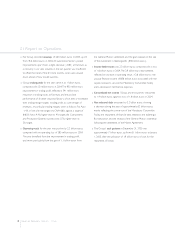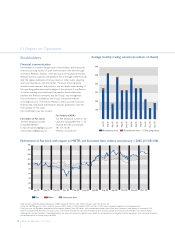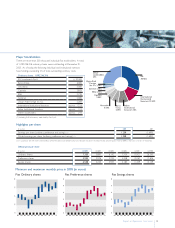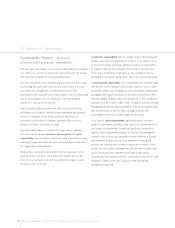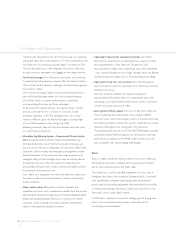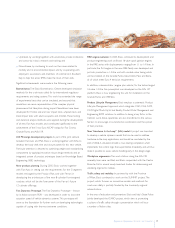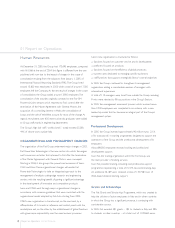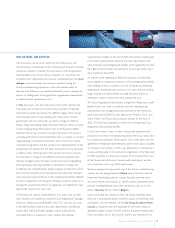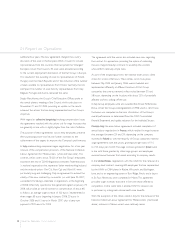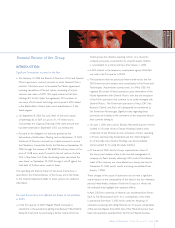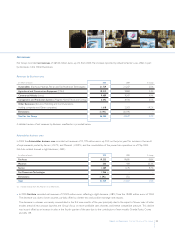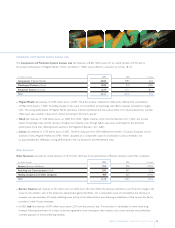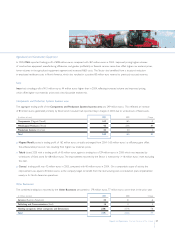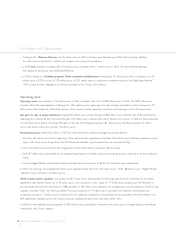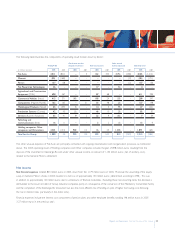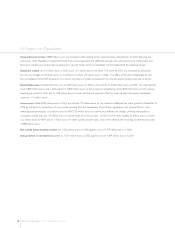Chrysler 2005 Annual Report Download - page 21
Download and view the complete annual report
Please find page 21 of the 2005 Chrysler annual report below. You can navigate through the pages in the report by either clicking on the pages listed below, or by using the keyword search tool below to find specific information within the annual report.
20 Reporton Operations Human Resources
01 Report on Operations
additional four years.The new agreement changed the country
allocation of the seats in the European Works Council to include
representatives from the countries that had joined the “enlarged”
European Union.The Council’s 30 seats were allocated according
to the current employment distribution of the Fiat Group in Europe.
This resulted in the awarding of seats to representatives of Poland,
Hungary and the Czech Republic and in the reduction of the number
of seats available to representatives from France, Germany, the U.K.
and Spain.The number of seats held by representatives from Italy,
Belgium, Portugal and Austria remained the same.
Sergio Marchionne, the Group’s Chief Executive Officer, spoke at
the annual plenary meeting of the Council, which took place on
November 21 and 22, 2005, providing an update on the results
achieved, the actions that are being implemented and the Group’s
objectives.
With regard to collective bargaining involving compensation issues,
the agreements reached with the unions call for wage increases that
are generally in line with or slightly higher than the rate of inflation.
The purpose of these agreements was to help employees preserve
their purchasing power and link any further increases to the
achievement of the targets to improve the Company’s performance.
In Italy, metalworking companies began negotiations for a two-year
renewal of the compensation provisions of the National Collective
Labour Agreement for Metalworkers (white and blue collar).This
contract, which covers about 75,000 of the Fiat Group’s employees,
expired at the end of 2004. Negotiations between Federmeccanica
(a national organisation that represents Italian metalworking industry)
and the national unions (Fim-Cisl, Fiom-Cgil and Uilm-Uil) were
particularly long and challenging. Only an agreement to extend the
validity of the new contract by six months (i.e., until June 30, 2007)
succeeded in breaking a stalemate in negotiations at the beginning
of 2006. When fully operational, the agreement signed on January 19,
2006 will provide an overall increase in compensation of about 6%,
as follows: an average wage increase of 100 euros (implemented in
three stages: 60 euros beginning in January 2006, 25 euros in
October 2006 and 15 euros in March 2007) plus a lump-sum
payment of 320 euros for 2005.
The agreement with the unions also included new rules regarding
the contract for apprentices, providing the option of extending
the use of apprenticeship contracts to assembly line workers
who perform relatively simple tasks.
As partof the bargaining process, the national trade unions called
strikes for a total of 60 hours.These strikes, which took place
between May 2005 and January 2006, were scheduled and
implemented differentlyat different locations. At Fiat Group
companies, the contract renewal strikes varied between 30 and
58 hours, depending on the location, with about 25% of potentially
affected workers walking off the job.
In ItalyGroup employees were also awarded the Annual Performance
Bonus. Under the Group-wide Agreement of 1996, which is still in force,
the bonus was computed on the basis of indicators of the Group’s
overall performance, as determined from the 2004 Consolidated
Financial Statements, and quality indicators for the individual Sectors.
Outside Italy, the main labour agreements included completion of
annual labour negotiations in France, which resulted in wage increases
that averaged between 2% and 3%, depending on the company
involved. In Poland as well, the majority of Group companies reached
wage agreements with the unions, granting average raises of 110
to 150 zlotys per month.The wage increases granted in Brazil were
in line with those granted by other large groups, and employees
received annual bonuses that varied according to company results.
In the United States, negotiations with the UAW for the renewal of a
company-level contract covering 650 employees that are represented
by the UAW at CNH plants in Racine, Wisconsin, and Burlington,
Iowa, and at an engineering centre in Burr Ridge, Illinois, and a depot
in St. Paul, Minnesota, were completed in March.This agreement
provided wage increases that were in line with those offered by
competitors. At the same time, it enabled CNH to reduce costs
in particular by scaling back retiree health-care benefits.
With the exception of the strikes called in Italy for the renewal of the
National Collective Labour Agreement for Metalworkers (mentioned
above), instances of labour unrest were relativelyminor.


